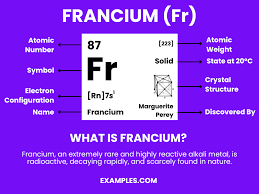Let’s learn what the most reactive metal francium is. Francium is in the second position of the lightest alkali metal. It has the highest affinity for electrons and lowest energy ionization among all elements. Cesium is still considered by many as the most reactive metal on earth.

Francium has a life of 22 minutes which is half-life. Fr-223 is the only isotope of Francium that occurs naturally. Apart from laboratory synthetization, only a few dozen francium can be present in a natural sample. The estimation for natural presence is only around 30 grams in the crust of Earth. The existing amount is in consistent transition and change, making it an almost nonexistent element.
What Determines Radioactivity?
Being reactive refers to the specific chemical species likely to engage in a chemical reaction easily. For example, fluorine is a highly electronegative element that easily bonds with electrons.

Reactivity refers to the likelihood of a chemical species engaging in a chemical reaction to create bonds. Highly electronegative elements, like fluorine, have a strong attraction for bonding electrons. Likewise, francium bonds with electronegative atoms easily and faster than other metals. Subsequently, if you set a periodic table and derive a column or group, the atomic radius expands. This sends the electrons even further from the positive nucleus. Afterwards, the electrons can be removed easily allowing the atoms to create chemical bonds. Thus, the more the size of the atom increases, reactivity increases.
Which Metals are Contending to be the Most Reactive Metal?
Though cesium ranks highest in capacity to displace other metals in chemical reactions, francium is expected to react more readily with water and acid. However, francium has less empirical evidence to prove given its’ limited presence on Earth.

On the other hand, fluorine, a nonmetal, possesses the highest electronegativity to is much reactive than many metals. Faster as a nonmetal. Therefore, cesium and fluorine are the two most reactive metals after francium.
Book references also cite Potassium as the most reactive metal because it is widely used in the laboratory for chemical bonding comparatively to francium and cesium.
How to Utilize The Most Reactive Material Francium
Is francium useful? Commonly it is “not.”
Under these circumstances, what are the applications of francium particularly for humans?
While chemists refer to Francium as the most reactive metal found so far, it is mostly an element produced in the lab. Only a handful amount is produced given its’ less utility. Besides, this metal is one of the most costly metals in the world. It costs around a billion per gram.
Therefore, the practical implications of Francium are still out of question due to its rarity and unstable nature. So far, scientific experiments have used only a limited amount to measure its chemical properties.
- The span of half-life for a metal decides how long a reactive sample takes to decay. Francium only has a half-life of 22 minutes, which determines that within 45 minutes, only a quarter of the original sample remains. Such a short half-life makes the biological process of utilizing this metal for any experiment quite difficult.
- Apart from research utilization, francium does not have many business or field applications. Primarily, researchers and chemists use francium to study the structure of atoms. Nonetheless, cancer researchers have used francium in a small amount to conduct cancer diagnosis for treatment and related spectroscopic experiments.
As francium is the most reactive metal, researchers cannot overlook the estimated risks during the experiments:
- Though francium is a reactive metal, its little presence in nature perceives it as a low-risk material to humans.
- In contrast, collecting or producing it in a large amount can be destructive to the environment and human life. Considering that it has a short half-life, the environmental impact is minimal.
- Scientists identify two visible risks with handling francium. Radioactivity is a mere concern
- Secondly, while decaying, francium emits high-energy elements. If a human comes in contact with these radio-active particles, it can burn or damage skin tissues, affecting the DNA in the worst cases. This may lead to cancer later. For example, though the risk factor is low due to its’ short life, some smoke detectors do francium emission. This way, the radiation of francium in smoke detectors lasts far longer.




















